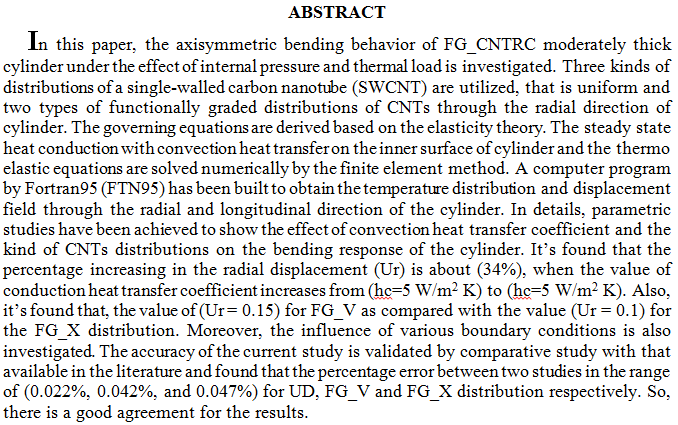
The study was carried out to determine the cytotoxic, antioxidant and gastro-protective effect of ethyl-4-[(3,5-di-tert-butyl-2-hydroxybenzylid ene)amino] benzoate (ETHAB) in rats.
 (41)
(41)
 (37)
(37)
 (11)
(11)
 (10)
(10)
 (5)
(5)
 (3)
(3)
In this study, biodiesel was prepared from chicken fat via a transesterification reaction using Mussel shells as a catalyst. Pretreatment of chicken fat was carried out using non‐catalytic esterification to reduce the free fatty acid content from 36.28 to 0.96 mg KOH/g oil using an ethanol/ fat mole ratio equal to 115:1. In the transesterification reaction, the studied variables were methanol: oil mole ratio in the range of (6:1 ‐ 30:1), catalyst loading in the range of (9‐15) wt%, reaction temperature (55‐75 °C), and reaction time (1‐7) h. The heterogeneous alkaline catalyst was greenly synthesized from waste mussel shells throughout a calcin
... Show More (6)
(6)
 (4)
(4)
Abstract
The purpose of our study was to develop Dabigatran Etexilate loaded nanostructured lipid carriers (DE-NLCs) using Glyceryl monostearate and Oleic acid as lipid matrix, and to estimate the potential of the developed delivery system to improve oral absorption of low bioavailability drug, different Oleic acid ratios effect on particle size, zeta potential, entrapment efficiency and loading capacity were studied, the optimized DE-NLCs shows a particle size within the nanorange, the zeta potential (ZP) was 33.81±0.73mV with drug entrapment efficiency (EE%) of 92.42±2.31% and a loading capacity (DL%) of 7.69±0.17%. about 92% of drug was released in 24hr in a controlled manner, the ex-vivo intestinal p
... Show More (14)
(14)
 (6)
(6)
This study uses an environmentally friendly and low-cost synthesis method to manufacture zinc oxide nanoparticles (ZnO NPs) by using zinc sulfate. Eucalyptus leaf extract is an effective chelating and capping agent for synthesizing ZnO NPs. The structure, morphology, thermal behavior, chemical composition, and optical properties of ZnO nanoparticles were studied utilizing FT-IR, FE-SEM, EDAX, AFM, and Zeta potential analysis. The FE-SEM pictures confirmed that the ZnO NPs with a size range of (22-37) nm were crystalline and spherical. Two methods were used to prepare ZnO NPs. The first method involved calcining the resulting ZnO NPs, while the second method did not. The prepared ZnO NPs were used as adsorbents for removing acid black 210
... Show More (6)
(6)
 (3)
(3)
In this study, biodiesel was prepared from chicken fat via a transesterification reaction using Mussel shells as a catalyst. Pretreatment of chicken fat was carried out using non‐catalytic esterification to reduce the free fatty acid content from 36.28 to 0.96 mg KOH/g oil using an ethanol/ fat mole ratio equal to 115:1. In the transesterification reaction, the studied variables were methanol: oil mole ratio in the range of (6:1 ‐ 30:1), catalyst loading in the range of (9‐15) wt%, reaction temperature (55‐75 °C), and reaction time (1‐7) h. The heterogeneous alkaline catalyst was greenly synthesized from waste mussel shells throughout a calcin
... Show More (6)
(6)
 (4)
(4)
 (71)
(71)
 (55)
(55)
In the present study, magnet silica-coated Ag2WO4/Ag2S nanocomposites (FOSOAWAS) were fabricated via a multistep method to address the drawbacks related to single photocatalysts (pure Ag2WO4 and pure Ag2S) and to clarify the significant influence of semiconductor heterojunction on the enhancement of visible-light-driven organic degradation. Different techniques were performed to investigate the elemental composition, morphology, magnetic and photoelectrochemical properties of the fabricated FOSOAWAS photocatalyst. The FOSOAWAS photocatalyst (1 g/L) exhibited excellent photodegradation efficiency (99.5%) against Congo red dye (CR = 20 ppm) after 140 min of visible-light illumination. This result confirmed the ability of the heterojunction be
... Show More (88)
(88)
Lasmiditan (LAS) is a recently developed antimigraine drug and was approved in October, 2019 for the treatment of acute migraines; however, it suffers from low oral bioavailability, which is around 40%.
This study aimed to improve the LAS bioavailability via formulation as nanoemulsionbased in situ gel (NEIG) given intranasally and then compare the traditional aqueous-LASsuspension (AQS) with the two successful intranasal prepared formulations (NEIG 2 and NEIG 5) in order to determine its relative bioavailability (F-relative) via using rabbits.
 (4)
(4)
 (3)
(3)
